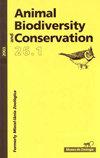The signal crayfish Pacifastacus leniusculus (Dana, 1852) (Crustacea, Decapoda) is threatening the near future of Margaritifera margaritifera Linnaeus, 1758 (Bivalvia, Unionoida) in the Negro River (NW Zamora, Spain)
IF 1
4区 环境科学与生态学
Q3 BIODIVERSITY CONSERVATION
引用次数: 0
Abstract
We studied the incidence of the signal crayfish on a population of Margaritifera margaritifera in the Negro River (Zamora, Spain) during the summers of 2019 to 2022. The incidence of predation was assessed as a mortality factor in relation to floods and the hydrology of the river. The crayfish were trapped in a small plot of high pearl mussels density monitored since 2002, and collected each summer since 2019, during which time their abundance increased (65 % in three years). Simultaneously, we counted the shells carried by the floods to the gravel riverbanks. The incidence of floods was stable between 2019 and 2022 (10.3 % to 19.4 % of mortality), while at the bottom of the river the mortality of pearl mussels increased due to predation from 2.7 % to 43.3 %. During the 2022 dry season, 29 pearl mussels that had recently died and whose shell edges were widely gnawed by crayfishes were collected from the plot. The shells appeared bitten only in the contour exposed above the gravel, ruling out the possibility that the marks could be the effect of the scavenging of dead specimens by the crayfish. Low intensity trapping barely affected the crayfish population, since the following year their abundance in the controlled section had recovered.信号小龙虾Pacifastacus leniusculus (Dana, 1852)(甲壳纲,十足目)在内格罗河(西班牙西北部萨莫拉)威胁着Margaritifera Margaritifera Linnaeus, 1758 (Bivalvia, Unionoida)的未来。
我们研究了信号小龙虾在2019年至2022年夏季内格罗河(西班牙萨莫拉)Margaritifera种群中的发病率。捕食率被评估为与洪水和河流水文有关的死亡因素。自2002年以来,这些小龙虾被困在一小块高珍珠贻贝密度的土地上,并自2019年以来每年夏天收集,在此期间,它们的丰度增加了(三年内增加了65%)。同时,我们数着被洪水冲到砾石河岸上的贝壳。2019年至2022年期间,洪水的发生率保持稳定(占死亡率的10.3%至19.4%),而在河底,由于捕食,珍珠贻贝的死亡率从2.7%上升到43.3%。在2022年旱季期间,从该地块收集了29只最近死亡的珍珠贻贝,这些贻贝的贝壳边缘被小龙虾广泛咬伤。这些贝壳只在露出砾石上方的轮廓上被咬过,这就排除了这些痕迹是小龙虾啃食死亡标本造成的可能性。低强度的捕集对小龙虾的数量几乎没有影响,从第二年开始,控制区域的小龙虾数量已经恢复。
本文章由计算机程序翻译,如有差异,请以英文原文为准。
求助全文
约1分钟内获得全文
求助全文
来源期刊

Animal Biodiversity and Conservation
农林科学-动物学
CiteScore
2.00
自引率
0.00%
发文量
21
审稿时长
>12 weeks
期刊介绍:
Animal Biodiversity and Conservation (antes Miscel·lània Zoològica) es una revista interdisciplinar, publicada desde 1958 por el Museu de Ciències Naturals de Barcelona. Incluye artículos de investigación empírica y teórica en todas las áreas de la zoología (sistemática, taxonomía, morfología, biogeografía, ecología, etología, fisiología y genética) procedentes de todas las regiones del mundo. La revista presta especial interés a los estudios que planteen un problema nuevo o introduzcan un tema nuevo, con hipòtesis y prediccions claras, y a los trabajos que de una manera u otra tengan relevancia en la biología de la conservación. No se publicaran artículos puramente descriptivos, o artículos faunísticos o corológicos en los que se describa la distribución en el espacio o en el tiempo de los organismes zoológicos.
 求助内容:
求助内容: 应助结果提醒方式:
应助结果提醒方式:


